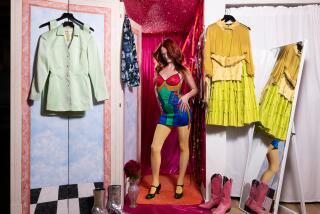Steven Stolman’s new ‘Scalamandre: Haute Decor’
- Share via
Hear the name “Scalamandré,” and those in the know think Italian luxury. Others picture the company’s famed chinoiserie and think high French style.
But one of the surprises in Steven Stolman’s new book about the legendary fabric and wallpaper company is the extent to which Scalamandré is actually a very American story — founded in 1929 by an Italian immigrant on Long Island. “Like so many other businesses born out of the Depression,” Stolman said during an L.A. stop on his book tour, “I think that has a lot to do with the grit of immigrants, who fled some kind of depression at home and came to America with such drive.”
As president of the company, Stolman has been leading his own drive, reviving the Scalamandré brand by putting its signature patterns on Lenox china, launching a Scalamandré lighting collection this fall and unleashing the company’s beloved zebra pattern on sheets and pillows sold through Neiman Marcus, Gracious Home and Horchow.
Those zebras also prance across the front on Stolman’s book, “Scalamandré: Haute Décor” (Gibbs Smith, $75), which covers more than eight decades of Scalamandré in American decorating. To call it a corporate history is like referring to 1600 Pennsylvania Ave. as merely a family home.
PHOTO GALLERY: “Scalamandré: Haute Décor”
Through photos, preserved letters and other tidbits from the Scalamandré archives, Stolman takes readers on time travels. For this edited conversation, he talked about how Franco Scalamandré and wife Flora built a legacy that starts with a 1930s historical restoration of Mt. Vernon and later Monticello, continues through Kennedy and Clinton redecorations of the White House and lives on inside recent show houses where contemporary designers have put fresh spins on decades-old prints.
Off the top of your head, if you had to cite the most famous American homes where Scalamandré fabrics or wallpaper could be found, which come to mind first?
The White House, without question, the jewel in the crown. Hearst Castle. The great mansions of Newport [R.I.]. We just did the pool lounges at the iconic Beverly Hills Hotel.
I love the photo of Adriana Scalamandré’s handpainted botanical, in which she hid her name in the branches. Did you know of that design before writing the book?
When I joined the company, I opened the archives and there it was.
What are the archives like? If I were to visit, what woud I see?
They take up about 2,000 square feet, floor to ceiling, in a windowless space buried deep in a big building, heavily protected behind lots of locks and alarms. Most of the company’s value is in its archives. There is an example of absolutely every pattern produced by Scalamandré from the 1920s to now, arranged in chronological order — archival boxes with fitted cloth muslin covers, categorized by style number. There is an accompanying card catalog. It’s filled with cards with more information, written by hand. The idea of digitizing this archive is probably the most essential task that has to happen.
Biggest Scalamandré moment? Luciano Pavarotti shedding a tear on the Scalamandré curtain at the Metropolitan opera house?
Honestly, I didn’t know we made the curtain for the Met until I found the work order. I literally started to cry. It’s called a Mozart curtain. It swoops up and ties back. I remember the first time I saw it, I was awestruck. You can’t believe something that big moves that gracefully. That was his farewell performance at the Met in “Turandot.”
You have a photo of Michelle Obama in the Red Room of the White House, taken by Annie Leibovitz for Vogue. How did you score that for the book?
It’s called paying for the rights. When I saw it in Vogue, I knew I wanted it for the centerpiece of the book. Everything [upholstery, curtains, wallpaper] you see besides the Michael Kors dress is Scalamandré. By total coincidence I met Annie last weekend in Connecticut in a little country market in Bridgeport. She was standing in the checkout line with me. I turned around and said, “Please forgive me, but I’m a big fan, and I just finished my first book, and it features this iconic moment you captured.” She said, “That’s so kind.”
Twitter: @cnakano | Email: craig.nakano@latimes.com
JOIN THE CONVERSATION:@latimeshome | pinterest.com/latimeshome | facebook.com/latimeshome | facebook.com/latimesgarden









